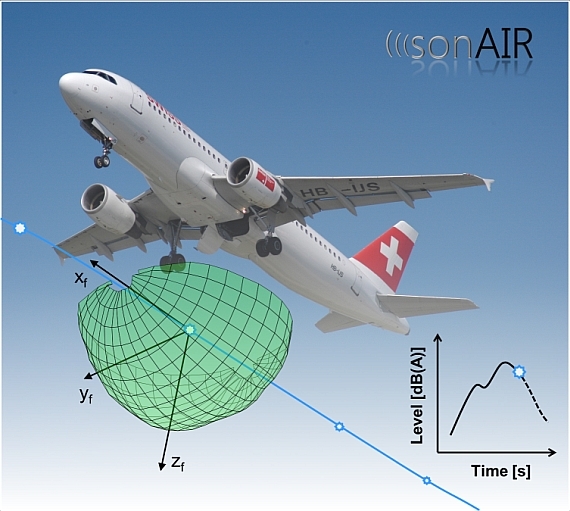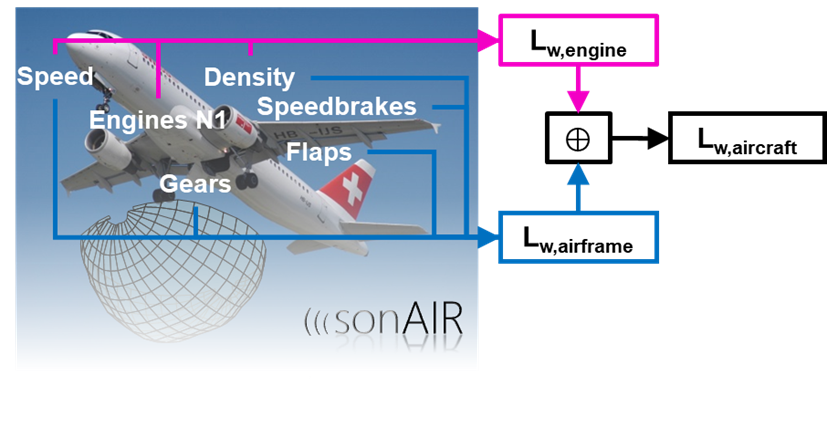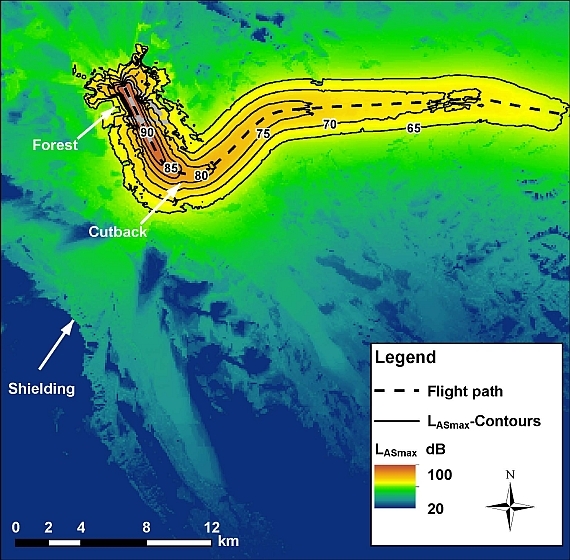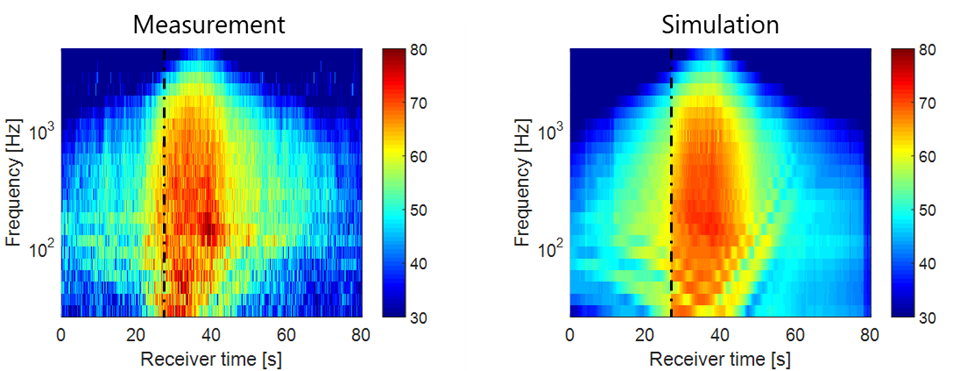sonAIR
sonAIR is a calculation model for aircraft noise developed by Empa's laboratory for Acoustics/Noise Control Wunderli et al. (2018). At the heart of sonAIR lies a source model that provides a detailed description of direction-dependent noise emissions in relation to flight conditions, such as power setting and aircraft configuration (e.g. flap and landing gear position). Emission data sets are created based on real air traffic measurements, primarily at Zurich Airport. The emission model is combined with Empa's sonX sound attenuation model. Single-flight simulations are carried out using a time-step procedure. sonAIR can be used to simulate and optimize the acoustic footprint of individual flights, as well as to calculate and compare annual noise levels and scenarios. From 2026 on, sonAIR will be recommend by the Federal Office for the Environment FOEN as the only model for official aircraft noise calculations in Switzerland.

Source Models
sonAIR was developed for fixed-wing aircraft with jet propulsion. At the heart of sonAIR is a source model Zellmann et al. (2018) that calculates direction-dependent sound emissions as a function of flight conditions, providing one-third octave band spectra ranging from 20 Hz to 5 kHz. The partial sound source model provides separate information on engine noise, depending on engine speed (N1), speed, and the longitudinal and lateral emission angles (θ and φ), as well as on airframe noise, depending on speed, longitudinal emission angle (θ), and — if available — flap position, speedbrakes, landing gear, air density, and airspeed. The energetic sum of these two models provides direction-dependent sound power levels depending on the flight conditions.
The level of detail in the emission models depends on the quality of the input data:
(a) The directivity can be 2D or 3D.
(b) Ideally, the emission calculation takes into account not only the power setting, but also information on the flight configuration, such as the position of the flaps and landing gear.
(c) For reduced models, no information on the aircraft configuration is needed for simulation.
(d) If neither the power setting nor the configuration are known, procedural models are created which statical-ly represent the average conditions of certain flight phases.
In addition to jet-powered aeroplanes, emission models were also created for propeller-powered aeroplanes, military fighter jets, helicopters and drones, which use different input parameters depending on the character-istics of the source.

Determination of source data
Ideally, the source models are based on our own measurements, either of real air traffic, typically at Zurich Airport, or of specific test flights. As an alternative to measurement data, emission models from other sources can also be integrated, such as from the SANC-DB (Swiss Aircraft Noise Calculation DataBase) (Leitfaden Fluglärm).
Source models are created by calculating the measured spectra back to the source (known as back propagation) and linking them to the corresponding flight conditions. This takes into account the propagation times of sound, the Doppler effect (frequency shift and intensity), and all important propagation phenomena, including the ground effect and the respective vertical stratification of the atmosphere in terms of temperature, humidity, wind and air pressure.
With regard to model development, FDR data (flight deck recordings; ‘cockpit data’) provide an ideal basis for correlating the acoustic measurements with the respective aircraft condition. These were kindly made available to us by the airlines Swiss, Edelweiss and Helvetic for their aircraft types.
If no cockpit data is available, the speed of the engine's primary shaft, N1, can be determined from the acoustic measurements using pure tone detection Ramseier et al. (2024).
A complete overview of the emission models available for sonAIR can be found in the sonAIR documentation.
Sound propagation model
In sonAIR, sound propagation is calculated using the sonX sound propagation model, which was developed and is maintained by the Laboratory for Acoustics/Noise Control at Empa. This model considers reflections on the ground ('ground effect'), the effects of obstacles, air attenuation, vegetation attenuation, and meteorological influences. It can also simulate reflections and shielding by artificial objects, such as buildings or noise barriers, as well as natural objects, such as forests and rocks. sonX is also used for other types of noise, such as shooting, road and railway noise.
Single flight simulation and superposition to yearly noise maps
The aircraft noise simulation uses a time-step method that simulates individual flights in the model. The position and orientation of the aircraft in space as well as the power setting and configuration are accounted in a fine temporal resolution of typically one second. This makes it possible to show the noise exposure at each receiver point in detail and to determine not only spectra but also level-time curves.
For the calculation of annual exposures and other complex scenarios, representative noise footprints of individual flights are calculated per aircraft type and route. If radar data of flight operations are available, this is done by simulating a larger number of individual flights (at least 100 per aircraft type and route; usually significantly more). In the case of idealized tracks and profiles, flights are simulated on main and side tracks and a weighted average is calculated. Based on a movement statistic, subdivided for different assessment periods, an energetic superposition of the footprints to an overall impact is then carried out.

Implementations
Empa develops sonAIR and operates a scientific implementation (sonAIR-WS), which serves as a development environment, research tool and reference implementation. Depending on the component, development is carried out in Matlab, Python and C++.
sonAIR was also implemented as an add-in for ArcGIS Pro from Esri by the company n-Sphere AG as a GIS-based software solution. sonAIR-DL (DL for services in German) is based on the D-noise product solution from n-Sphere and, depending on the license level, covers the entire process, from data import and noise calculation (simulation) to evaluation, analysis and provision of the results in the form of maps and reports, as well as for the simulation and assessment of targeted measures. sonAIR-DL can be obtained from n-Sphere in various license levels. Licenses for noise mapping in accordance with the Swiss Noise Abatement Ordinance and for research purposes are free of charge.
Results
In the single flight simulation, level-time curves are calculated as one-third octave band spectra from 20 Hz to 5 kHz with a temporal resolution of 1 s. The results are typically stored as A-weighted event levels LAE and/or maximum levels LASmax as raster files (so-called noise footprints). From this, A-weighted event levels LAE and/or maximum levels LASmax are typically saved as raster files (so-called noise footprints) as results. From the number of movements for a specific assessment period, average levels LAeq can be derived from the event levels, which in turn can be used to determine other variables such as rating levels in accordance with the Swiss Noise Abatement Ordinance.
sonAIR-WS offers additional evaluation options. For example, the number of people affected can be calculated from the annoyance during the day or the wake-up reactions at night (based on individual events or entire scenarios). Alternative metrics such as EPNL or loudness can also be calculated and displayed.

Validations
sonAIR has already been validated several times in comparison with independent measurements, primarily by Empa itself Jäger et al. (2021), Wunderli et al. (2022), but also by other research institutions Boelhouwer et al. (2024). sonAIR is able to predict single event levels of overflights with a mean deviation of < 0.5 dB and a standard deviation of < 2 dB. If detailed input data is available, sonAIR is superior to other aircraft noise calculation models; if only reduced input data such as the aircraft position is available, sonAIR can only utilise its advantages to a limited extent and the calculation uncertainty is of the same order of magnitude as with other models Meister et al. (2021).
Preparation of calculation input data
Various input data is required to calculate emissions with sonAIR. Position data is central. 3D trajectories can be generated either from flight tracks in combination with climb profiles via a convolution within sonAIR-DL. Empa can also use radar or ADS-B data as input variables, which are processed separately and also provide 3D trajectories. In addition to data on the position and speed of the aircraft, information on thrust setting and configuration is also required (see section on source models). As this data is generally not accessible, Empa has developed parameter estimation methods Schwab et al. (2020), Meister (2024), Meister et al. (2025).
History
| 2013 - 2015 | Initial development of sonAIR: In 2013 and 2014, extensive measurements of real flight operations were carried out in the near and far range of Zurich Airport in order to record the most important large aircraft operating in Switzerland. A total of around 2,600 overflights were recorded with eight microphones each in the immediate vicinity of the airport and around 11,000 over-flights in the long-distance range of the airport at ten measuring points from Pfannenstiel to Winterthur and Bellikon (Aargau) over a period of six months. The sonAIR emissions model for fixed-wing aircraft was developed as part of Christoph Zellmann's dissertation (2013-2017), with a method for separating the partial noise sources on fixed-wing aircraft and creating separate regression models for engine and airframe noise Zellmann (2018), Zellmann et al. (2018). |
| 2016 | Aircraft noise measurementes in Grenchen: Creation of emission models (phase models) for propeller aircraft and helicopters. |
| 2017 - 2018 | sonAIR validation and extensions of the emission database: Extension of the emission database with recently introduced aircraft types by Swiss and validation of sonAIR with independent measurements at Zurich and Geneva airports. |
| 2017 - 2018 | sonAIR parameter estimation: Development of a method to estimate thrust setting (N1) based on position data from radar tracks Schwab et al. (2020). |
| 2017 - 2019 | sonAIR monitoring: Further extension of the emission database based on additional measure-ments at Zürich airport. |
| 2018 - 2020 | Pilot assisting system for low noise landing procedures (LNAS): Use of sonAIR to optimise approach procedures including demonstration flights at Zurich airport Jäger et al. (2021). |
| 2018 - 2020 | NKF: Measurement campaign for military fighter aircraft as part of the evaluation process for a new fighter jet in Switzerland. |
| 2019 - 2020 | Multicopter: Development of a calculation tool for low-noise operation of multicopters including emission models Wunderli et al. (2023). |
| 2020 | CompAIR: Comparison of the aircraft noise tools FLULA2, AEDT und sonAIR with measurements of real air traffic Meister et al. (2021). |
| 2020 - 2021 | Zurich and Geneva airports: first calculation of annual noise exposure maps for 2017 with sonAIR. |
| 2020 - 2022 | DYNCAT (Optimized high-lift system for low noise approaches, including best configuration for landing): EU SESAR project to optimise approach procedures in terms of noise and fuel consumption Wunderli et al. (2024). |
| 2021 - 2022 | sonAIR_LOOP: Additional annual exposure calculations with the sonAIR DL tool incl. sensitivity analyses for calculation settings Schalcher et al. (2025). |
| 2021 - 2022 | MEI reflections: Investigation at Meiringen airfield on the influence of buildings and forest and rock reflections on aircraft noise exposure Ramseier et al. (2024). |
| 2021 - 2023 | AirCLOUD (Aircraft noise – Capturing spectraL sOund soUrce Data): Expansion of the acoustic source database of civil aircraft; determination of alternative methods to estimate N1 and the aircraft configuration Meister (2024), Meister et al. (2025). |
| 2022 - 2025 | D-KULT (Demonstration of the feasibility of eco-efficient flight trajectories): Development of low-noise approach and departure procedures at Frankfurt Airport, including validations in comparison with monitoring measurements of real traffic. |
| 2023 - 2026 | DYN-MARS (DYNamic Management of Aircraft Configuration and Route Structures): EU SESAR project to optimize efficient landing procedures and for better integration into the overall air traffic management. |
| 2024 - 2027 | STEPLESS: EU SESAR project to reduce the environmental impact of final approaches with con-ventional and increased glide slopes (IGS), by dynamic (continuous) flap settings. |
| 2025 - 2028 | CAVIA (Clean Aviation via intelligent Avionics): Optimisation of flight procedures of the Do 328eco turboprop aircraft, in cooperation with Deutsche Aircraft and the German Aerospace Institute DLR. |
Documentation
Detailed information on sonAIR can be found in the Empa documentation.

-
Share
